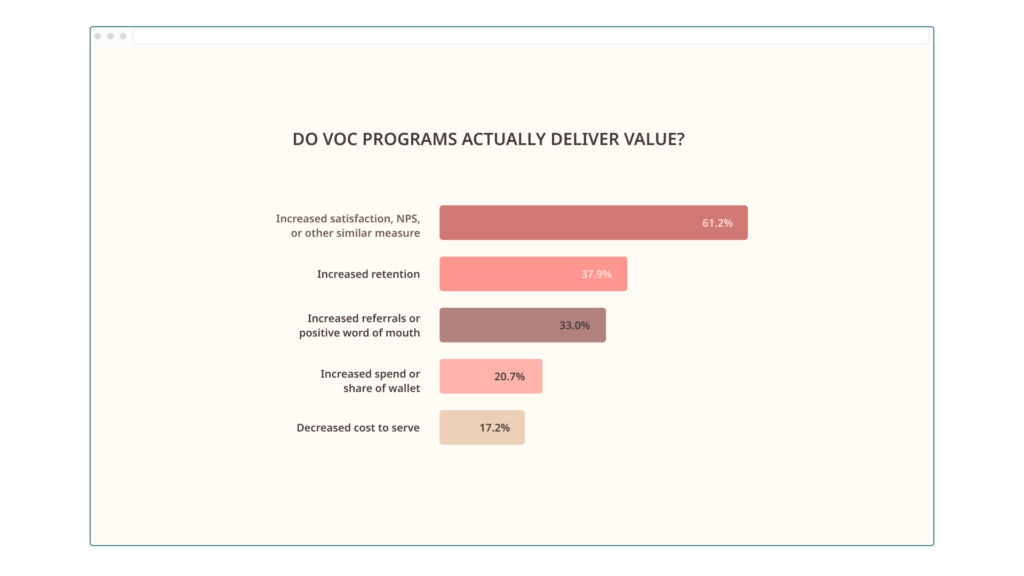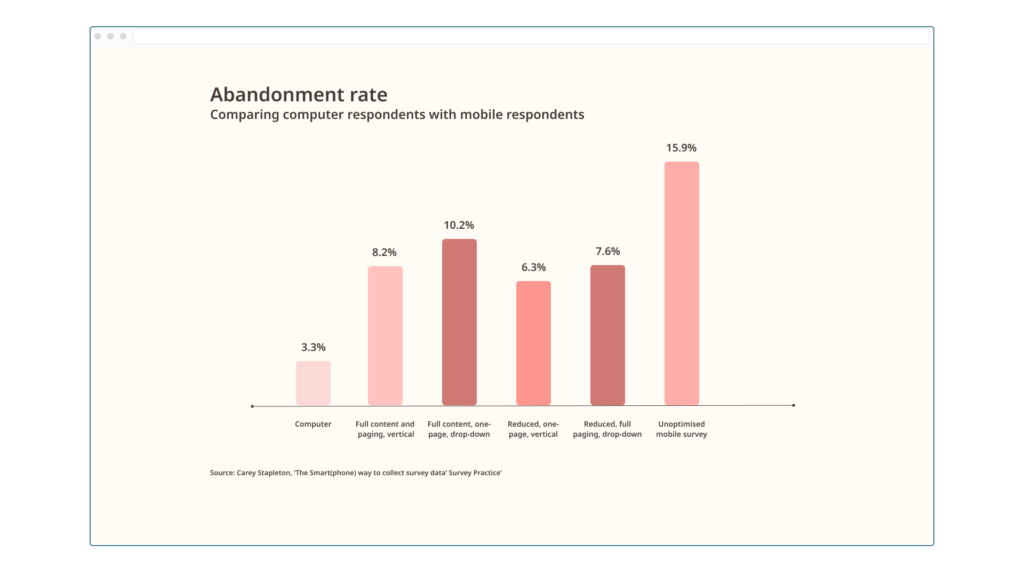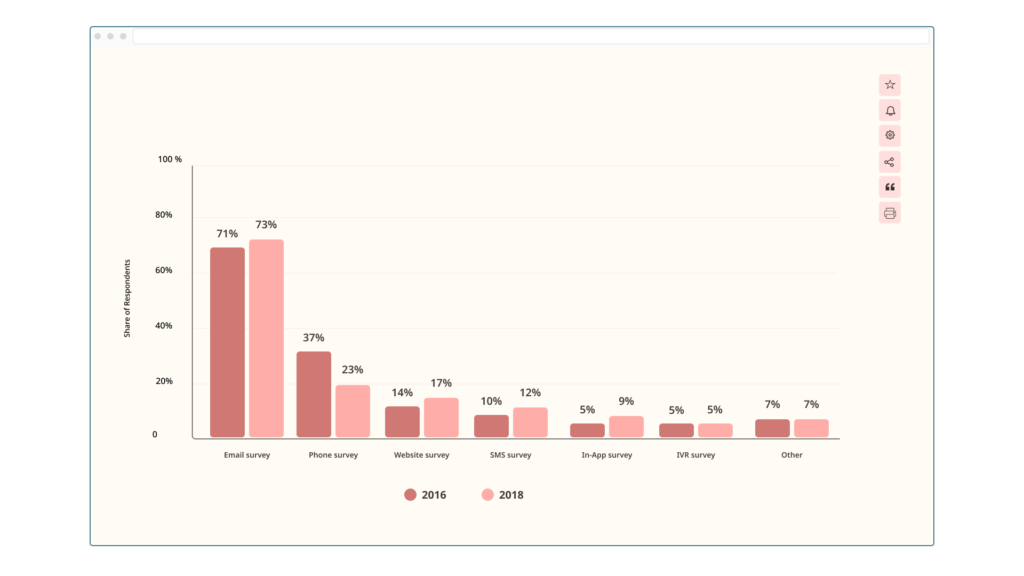Table of Contents
How to Build a Voice of Customer Survey that Increases NPS Step-by-Step

Imagine you had a direct line into your customers’ thoughts—what they love, what frustrates them, and what would make them stick with your brand for the long haul.
Well, that’s exactly what a Voice of Customer (VoC) survey can do for your business.
A well-crafted VoC survey goes beyond just collecting feedback. It uncovers valuable insights that help you improve products, fine-tune your messaging, and create experiences that truly resonate with your audience.
But here’s the catch: not all surveys are created equal. A poorly designed survey can lead to vague, misleading, or even completely useless data.
So, how do you create a VoC survey that delivers real, actionable insights?
In this guide, we’ll break down everything you need to know—from choosing the right questions to ensuring you get high-quality responses. Whether you’re launching your first survey or refining your approach, this step-by-step guide will help you gather customer feedback that actually drives results.
Voice of Customer vs. Customer Satisfaction
Voice of Customer (VoC) is gathering and analysing customer feedback to understand their needs, preferences, and pain points.
Customer satisfaction, on the other hand, is a measurement of how happy customers are with a product, service, or experience.
At first glance, they might seem like the same thing—but they’re not. Think of VoC as the deep dive into what customers really think, feel, and want, while customer satisfaction is more of a surface-level snapshot of how well you’ve met expectations.
VoC is proactive, uncovering insights that shape future decisions, while customer satisfaction is reactive, measuring past performance.
Why you should care about the Voice of Customer
If you want your business to thrive, listening to your customers isn’t optional—it’s a must. A solid Voice of Customer (VoC) strategy helps you understand what people really want, where you’re falling short, and how to create experiences that keep them coming back.
Here are just a few reasons why it matters:
- It makes customers happier (and more likely to stick around). A whopping 86% of buyers say they’ll pay more for a great experience. When you actively listen to customer feedback and make improvements, you’re not just meeting expectations—you’re exceeding them.
- More revenue, less guesswork. Companies that invest in customer experience can see an extra $700 million in revenue over three years. Why? Because happy customers buy more, stay longer, and tell their friends.
- People love brands that listen. 77% of consumers think more highly of brands that actively seek and act on feedback—ignoring customer insights. That’s a surefire way to lose trust (and business).
- It helps you grow in the right direction. Instead of making random changes, VoC gives you data-driven insights into what actually matters to your audience. That means smarter decisions, better products, and more loyal customers.
- It reduces customer churn. 86% of customers will leave a brand after just two or three bad experiences. VoC helps you fix problems before they drive people away.
At the end of the day, if you’re not listening to your customers, your competitors will be. A strong VoC strategy helps you stay ahead, keep your customers happy, and grow your business the right way.
And if that wasn’t enough, the numbers speak for themselves. Over 61% of businesses surveyed reported that their Voice of Customer programme increased customer satisfaction measures, such as NPS score.

How to create a Voice of Customer survey questionnaire
Creating a Voice of Customer (VoC) questionnaire isn’t just about throwing together a few questions. It’s about asking the right things in the right way so you get useful, actionable insights. Here’s how to do it step by step.
Step 1: Define Your Goal
Before you even think about writing questions, ask yourself: What do I want to learn?
- Are you trying to understand why customers choose (or don’t choose) your brand?
- Do you want feedback on a specific product or service?
- Are you looking for ways to improve the customer experience?
A clear goal helps you craft questions that get meaningful answers instead of generic responses. It also keeps your survey focused, so you don’t overwhelm your customers with unnecessary questions.
Step 2: Identify Your Target Audience
Not all customers are the same, and your survey shouldn’t be, either. Think about who you’re asking and tailor your questions to them. For example:
- New customers. Why did they choose you? What nearly stopped them from purchasing?
- Loyal customers. What keeps them coming back? What could make them even happier?
- Churned customers. Why did they leave? What would make them return?
- Prospective customers. What’s holding them back from buying?
Different audiences will have different insights, so segmenting them properly will help you gather more relevant data.
Step 3: Choose the Right Question Types
A great VoC questionnaire mixes different question types to get well-rounded insights. Here are the main types:
- Open-ended questions. Let customers share thoughts in their own words. (e.g., “What’s one thing we could do to improve your experience?”)
- Multiple choice questions. These help categorise responses quickly. (e.g., “What was the biggest factor in your decision to buy?”)
- Likert scale questions. These measure opinions on a scale. (e.g., “How satisfied are you with our service? (1-5)”)
- Ranking questions. Ask customers to prioritise options. (e.g., “Rank the following features in order of importance.”)
Using a mix keeps things interesting for your respondents and gives you richer data to work with. So in honour of that, here are a few more example questions you can use to cover each of these types:
- What’s the main reason you chose our product/service?
- What’s one thing we could do to improve your experience?
- Tell us about a time we exceeded (or failed to meet) your expectations.
- If you could change one thing about our company, what would it be?
- How did you first hear about us?
- What was the biggest factor in your decision to buy?
- On a scale from 1-10, how satisfied are you with your experience?
- How likely are you to recommend us to a friend? (1-10)
- How easy was it to use our product/service? (1-5)
- How well does our product meet your needs? (1-5)
- Was there anything that prevented you from ordering today?
- What would you like to be able to find in our product range?
Step 4: Keep It Short and Engaging
Nobody likes a long, boring survey—especially not your customers. The sweet spot? 5 to 10 minutes long, or around 10-15 questions.
Here are some tips to keep engagement high:
- Start with easy questions. Warm up respondents with simple, multiple-choice questions.
- Make it conversational. Instead of “Rate your satisfaction with the product,” try “How do you feel about the product so far?”
- Avoid jargon. Use language your customers actually use and understand.
- Respect their time. If a question isn’t essential to your goal, cut it.
- Use progress indicators. Show customers how far along they are to reduce survey fatigue.
- Keep the design simple. Avoid cluttered layouts that might distract or confuse respondents.
- Allow optional responses. Not every question may be relevant to every customer. Avoid forcing answers.
- Test for mobile-friendliness. Many customers will take the survey on their phone, so make sure it’s easy to navigate on smaller screens. In fact, respondents using phones experienced the highest abandonment rate when surveys weren’t optimised for mobile.

Step 5: Test Your Survey Before Sending
Testing your Voice of Customer (VoC) survey before you send it out is essential for gathering reliable, actionable insights. But how do you make sure your survey is ready to go? Here are some practical steps, resources, and tips to help you test and perfect your survey before it reaches your audience.
1. Run a Pilot Test
One of the most effective ways to test your survey is to run a small pilot with a select group of people. This could be colleagues, a few existing customers, or anyone who fits the profile of your target audience.
Ask them for feedback on things like clarity, ease of navigation, and whether any questions are confusing.
This helps you catch any problems early on, like questions that are hard to understand or that may make people abandon the survey halfway through.
2. Check the Survey Flow
Once your survey is designed, it’s important to make sure the questions flow logically. Try to put yourself in the respondent’s shoes—does the survey progress in a way that feels natural? Does each question lead into the next?
A smooth flow not only makes the survey easier to complete but also keeps respondents engaged and more likely to finish.
3. Eliminate Bias
One common pitfall in survey design is biased questions. You might unintentionally phrase questions in a way that suggests a certain answer.
For example, “How much do you love our product?” can lead respondents to give overly positive feedback. Instead, aim for neutral, open-ended questions that allow for honest responses. This ensures that the data you collect is as accurate as possible.
4. Test the Time It Takes
If your survey is too long, people may give up before finishing. During your test, time how long it takes for people to complete the survey. Ideally, you want it to take around 5-10 minutes. If it’s taking much longer, you might want to cut some questions or make them more focused to maintain respondent attention.
5. Make Sure It Works on Mobile
A lot of your respondents will likely be completing your survey on a mobile device, so it’s essential that your survey is mobile-friendly. Test it across multiple devices to make sure the layout looks good and all the features work properly. If your survey isn’t responsive, you might lose potential feedback, and people may abandon it mid-way.
6. Experiment with Different Question Formats
Testing different question formats can help you decide which ones are most effective for your target audience.
For example, while multiple-choice questions are great for quick responses, open-ended questions can give you more in-depth insights. But don’t overwhelm respondents with too many long-form questions—find a balance that allows you to collect meaningful data without losing their attention.
Step 6: Distribute It the Right Way
Where you send your survey matters as much as what’s in it. Here are a few distribution methods:

- Email surveys. Great for existing customers. Send a well-crafted email with a clear call to action and a short description of why their feedback matters. According to Statista, email is also the most popular survey distribution channel when targeting NPS.
- Website pop-ups. Catch users while they’re engaged. Keep the pop-up non-intrusive and trigger it at the right moment, such as after a purchase or after a certain time spent on a page.
- In-app surveys. Perfect for gathering feedback on a product experience. Ask questions while customers are actively using your app, keeping it short and relevant to their actions.
- Social media. Ideal for quick feedback from followers. Use polls, surveys, or even direct messages to reach your audience where they are most active.
- SMS surveys. Higher response rates, especially for urgent feedback. In fact, SMS surveys get 209% more responses than email, phone, and social media. Just remember to keep messages concise and include a direct link to the survey.
- QR codes on packaging or receipts. This is a great option for brick-and-mortar businesses, but can also work for e-commerce brand surveys. Customers can scan a QR code to leave feedback right after a purchase or experience.
- Customer support follow-ups. After resolving a support ticket, send a short survey asking about their experience.
Choose a method that fits your audience’s habits to maximise responses. You can also combine multiple channels to increase participation.
Step 7: Analyse the Results and Take Action
The worst thing you can do with a VoC survey? Ignore the results.
Once you’ve gathered responses, take the time to analyse patterns and take meaningful action.
- Look for recurring themes. Are multiple customers complaining about the same issue?
- Segment responses. Do new vs. loyal customers have different needs?
- Act on feedback. If people say they want a new feature, consider adding it.
- Close the loop. Let customers know you heard them by sharing what you’re improving based on their feedback.
How to design a successful Voice of Customer programme
A Voice of Customer (VoC) programme is a structured approach to collecting, analyzing, and acting on customer feedback. It goes beyond one-off surveys—it’s about continuously listening to customers and using their insights to shape your products, services, and overall experience.
A successful VoC programme doesn’t just gather data—it helps you understand why customers feel the way they do and what you can do to improve their experience.
Here’s how to design one that gets real results.
Step 1: Set Clear Objectives
Define what you want to achieve with your VoC programme. Are you trying to improve customer satisfaction, reduce churn, enhance product development, or refine your messaging? Having clear goals helps you collect the right kind of feedback and take meaningful action.
Step 2: Use Multiple Feedback Channels
Don’t rely on just one survey. Successful VoC programmes gather feedback from multiple sources, such as:
- Customer surveys (email, website, in-app)
- Social media listening
- Online reviews and ratings
- Customer support interactions
- Live chat and chatbot data
- User behaviour analytics
Using customer survey software like Netigate can help you centralise all these data sources and analyse feedback efficiently.
Netigate captures feedback from both employees and customers to improve your KPIs like NPS, CES, and CSat. From inside the platform, you can create, send, and analyse customer surveys through multiple channels, like online reviews, calls, chats, and more.
You can also see exactly what’s driving your KPIs up or down from the dashboard. You can book a demo here to see how it works.
Step 3: Ensure Data is Actionable
Structure your data collection so that responses can be categorised, analysed, and turned into actionable insights. Use dashboards and reporting tools to visualise trends, identify patterns, and prioritise key areas for improvement.
Step 4: Close the Feedback Loop
Show customers that their feedback matters by responding, making improvements, and communicating changes based on what they’ve said. A successful VoC programme ensures that customers know their voices lead to real changes.
Step 5: Measure Success and Iterate
Track the impact of changes you make based on VoC insights. Monitor key metrics like Net Promoter Score (NPS), Customer Satisfaction (CSAT), and Customer Effort Score (CES) over time. Keep refining your programme to ensure it continues to deliver value for both customers and your business.
Key VoC challenges and how to tackle them
Even the best Voice of Customer programmes run into obstacles. But don’t worry—every challenge has a solution. Here’s how to overcome some common VoC roadblocks.
Challenge 1: Low Survey Response Rates
You spend time crafting the perfect survey, but barely anyone responds. Frustrating, right?
How to Fix It:
- Keep surveys short and engaging (5-10 minutes max).
- Send surveys at the right time—right after a purchase or interaction tends to get higher engagement.
- Offer incentives, like discounts or freebies.
- Use multiple channels: email, SMS, website pop-ups, and social media.
Challenge 2: Getting Actionable Insights from Data
Collecting feedback is great, but what do you do with it?
How to Fix It:
- Use a customer feedback management system (like Netigate) to categorise responses.
- Identify trends: Look for recurring themes in open-ended responses.
- Use dashboards and reports to turn raw data into actionable insights.
Challenge 3: Closing the Feedback Loop
Customers take time to give feedback, but they never hear back from you. That’s a missed opportunity!
How to Fix It:
- Respond to feedback with personalised thank-yous.
- Share changes you’re making based on customer input.
- Use automated follow-ups to keep customers in the loop.
Challenge 4: Survey Fatigue
Customers get tired of answering surveys, leading to declining response rates.
How to Fix It:
- Only ask essential questions.
- Use progress bars to show survey completion status.
- Mix up formats (e.g., a mix of multiple-choice and open-ended questions).
Challenge 5: Internal Resistance to Change
Your VoC data suggests changes, but leadership isn’t on board.
How to Fix It:
- Present data-driven insights—numbers talk!
- Show how VoC-driven changes impact revenue and customer retention.
- Start small: Implement quick wins to demonstrate VoC’s value.
Conclusion
A well-crafted Voice of Customer survey helps you truly understand your customers, improve their experience, and drive business growth. The key is to ask the right questions, keep it short and engaging, and—most importantly—act on the insights you gather.
Start small, test different approaches, and always listen to what your customers are telling you. Want to see how easy it is to collect and analyse customer feedback? Book a demo today and take the guesswork out of your VoC strategy!
-
Netigate Marketing
-
Netigate Marketing
- 11 min read
- .






